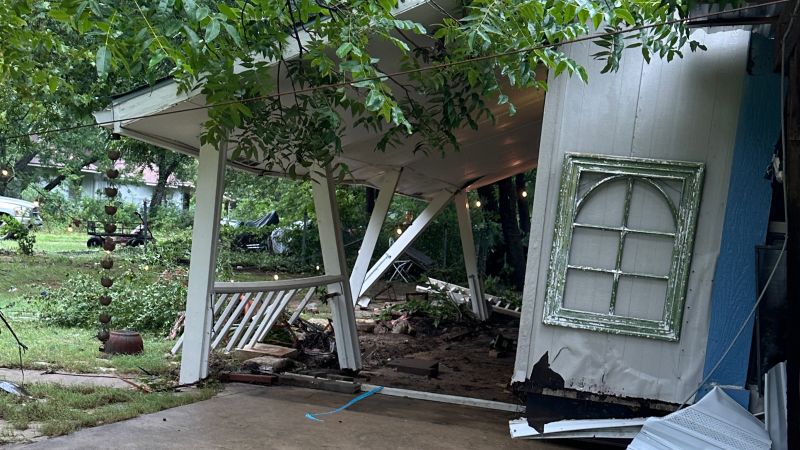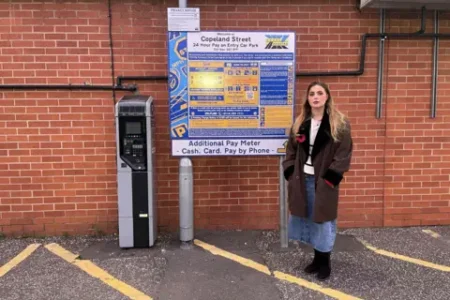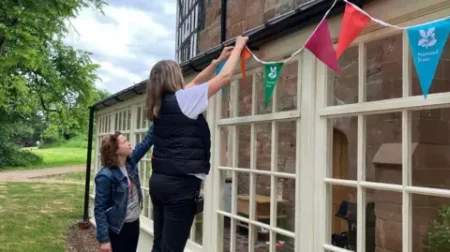In the quiet community of Jonestown, Texas, Crissy and Avi Eliashar found their home for thirteen wonderful years. It was a place full of cherished memories and stability until tragedy struck in the form of a catastrophic flood one early Saturday morning, washing away their residence, vehicles, and personal possessions without warning. This upheaval not only altered their physical environment but also threatened the family’s sense of safety and normalcy.
At the time of the disaster, Avi, a diligent security guard, was working his shift, unaware of the impending danger. Left to tackle the emergency alone, Crissy, a dedicated school teacher, faced the harrowing task of evacuating their three children: sons Beni (12) and Dov (10) and their 7-year-old daughter Mayaan. They were joined by a friend of Beni’s who was visiting for the night. In a heart-stopping moment, as floodwaters rose rapidly, Dov managed to save Mayaan from being swept away by grabbing her hair, a small but powerful reflection of sibling love amidst chaos.
“We nearly died. We were very lucky,” noted Crissy Eliashar, expressing gratitude that her family emerged without serious injuries, despite the immense loss they faced. However, the emotional and psychological impact of such a loss cannot be easily overlooked. The Eliashars, like many other flood victims in Texas, did not have flood insurance, as standard homeowners’ policies rarely cover damages caused by flooding. This unfortunate reality leaves many families exposed to devastating financial peril when disasters strike.
The emotional weight of losing their home, a place where the Eliashars had built their lives, cannot be overstated. Crissy described their home as “our everything,” highlighting the meaning it held as a space of stability, growth, and family life. The loss demanded that they rethink their entire existence, creating a daunting challenge for the family to rebuild from the ashes of their previous life.
FEMA’s statistics reveal a troubling trend: only about 4% of homes across the United States are covered by flood insurance, with even fewer homes in high-risk areas obtaining such essential protection. The financial burden and risk associated with providing flood coverage have caused many insurance companies to reduce their offerings, pushing homeowners towards government-provided options that require additional financial commitments for unpredictable events. Crissy admitted, “It was not an expense we thought of as necessary,” drawing attention to how easily people might dismiss the value of flood insurance, especially when past experiences suggest they are not in danger.
The Eliashars were among many who only realized the significant gap in their insurance coverage after facing such devastating losses. Data from FEMA indicated alarmingly low levels of flood insurance coverage in special flood hazard areas. As of 2018, only 30% of homes in these areas had flood insurance, a figure likely lower in light of the recent natural disasters experienced in Texas.
Rob Moore, head of the climate adaptation division at the National Resources Defense Council, commented on this decline in flood insurance coverage: “Flood insurance coverage peaked in 2017 but has been dropping steadily since then.” Factors include increasing premiums for those at higher risk and a general pullback on expenses amid rising inflation. Many homeowners believe that if they haven’t had to use flood insurance in the past, they can forgo it moving forward. However, this mentality is misleading and dangerous, resulting in a lack of preparedness for unexpected calamities.
The Eliashar family’s region, Travis County, recorded an alarmingly low rate of flood insurance, with only 2.2% of homes adequately covered. In the hardest-hit Kerr County, similarly low numbers indicated a widespread failure to protect residents from foreseeable risks. This situation is exacerbated by climate change, which has led to increased frequency and severity of storms across the United States.
As advocates and industry representatives stress the importance of understanding flood insurance coverage, many find themselves unaware of the risks they face. “Floods are the most common and costly natural disasters in the U.S.,” noted Loretta Worters, with the Insurance Information Institute. Yet, homeowners continue encountering the painful reality of inadequate insurance coverage only after experiencing severe losses.
Critics of the insurance industry point out that the exclusion of flood damage from standard homeowner policies has become commonplace as insurers prioritize profit margins over comprehensive coverage. Carmen Balber, executive director of Consumer Watchdog, articulated frustration over the trend of insurers shedding liability for different types of damage, ultimately leaving consumers vulnerable and unprotected.
Amidst their struggles, the Eliashar family is currently taking refuge in the home of a friend and attempting to raise funds through a GoFundMe campaign. With a few salvaged items from their submerged home, they grapple with the reality that their automobile’s water damage will be covered by car insurance, yet their home remains outside the protective umbrella of insurance, a situation that leaves Crissy feeling frustrated and angry.
“I haven’t even had time to get angry,” she confessed. “I mean,









